-
 Bitcoin
Bitcoin $84,868.5847
0.19% -
 Ethereum
Ethereum $1,637.5855
1.68% -
 Tether USDt
Tether USDt $0.9996
-0.01% -
 XRP
XRP $2.1507
0.12% -
 BNB
BNB $589.0970
-0.72% -
 Solana
Solana $133.7881
1.83% -
 USDC
USDC $0.9998
-0.02% -
 Dogecoin
Dogecoin $0.1661
0.62% -
 TRON
TRON $0.2564
3.84% -
 Cardano
Cardano $0.6506
0.77% -
 UNUS SED LEO
UNUS SED LEO $9.4193
0.63% -
 Chainlink
Chainlink $12.8376
-0.78% -
 Avalanche
Avalanche $20.1032
-0.19% -
 Stellar
Stellar $0.2414
-0.27% -
 Sui
Sui $2.2681
-3.68% -
 Shiba Inu
Shiba Inu $0.0...01230
-0.72% -
 Hedera
Hedera $0.1693
-2.04% -
 Toncoin
Toncoin $2.8602
-0.94% -
 Bitcoin Cash
Bitcoin Cash $350.6832
3.86% -
 Litecoin
Litecoin $79.1925
1.80% -
 Polkadot
Polkadot $3.7203
1.63% -
 Dai
Dai $1.0000
0.00% -
 Hyperliquid
Hyperliquid $15.9053
-1.11% -
 Pi
Pi $0.7539
1.33% -
 Bitget Token
Bitget Token $4.2969
-2.31% -
 Ethena USDe
Ethena USDe $0.9988
-0.02% -
 Monero
Monero $205.6051
-2.49% -
 Uniswap
Uniswap $5.4646
1.51% -
 Pepe
Pepe $0.0...07564
3.44% -
 OKB
OKB $53.0241
-3.45%
How to use the API interface of Binance Margin Trading?
To use Binance Margin Trading API, set up credentials, connect via HTTPS, and manage accounts, loans, orders, and positions programmatically.
Apr 11, 2025 at 01:21 am
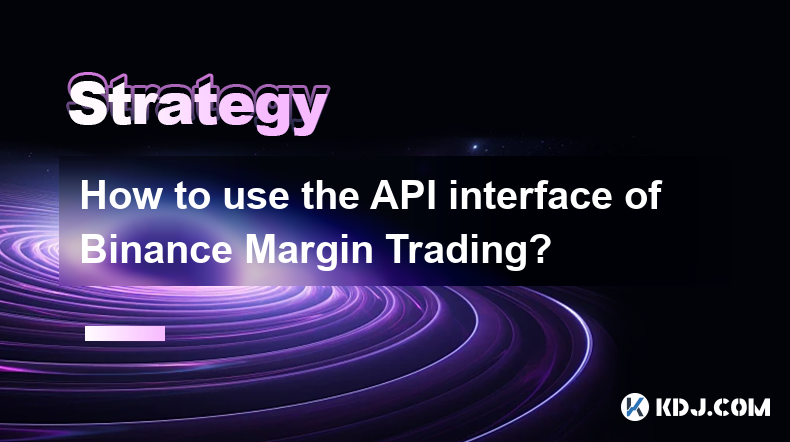
How to use the API interface of Binance Margin Trading?
Binance Margin Trading offers users the ability to trade with borrowed funds, amplifying potential returns (and risks). To interact with these features programmatically, Binance provides an API interface that allows developers to automate trading, manage positions, and analyze data. This guide will walk you through the steps and considerations for using the Binance Margin Trading API.
Understanding the Binance Margin Trading API
Before diving into the specifics of using the API, it's important to understand what the Binance Margin Trading API offers. This API allows you to perform actions such as creating and managing margin accounts, borrowing assets, placing margin orders, and repaying loans. The API endpoints are designed to interact with the margin trading system, and they require specific permissions to operate.
Setting Up Your API Credentials
To use the Binance Margin Trading API, you need to set up your API credentials. Here's how you can do it:
- Log in to your Binance account and navigate to the API Management section.
- Create a new API key. Make sure to enable the necessary permissions for margin trading, including 'Enable Margin Trading' and 'Enable Futures'.
- Save your API key and secret key securely. These keys are crucial for authenticating your API requests.
Connecting to the API
Once you have your API credentials, you can start making requests to the Binance Margin Trading API. Here's how to connect:
- Choose your programming language and use a library that supports HTTP requests and HMAC-SHA256 signing, such as Python's
requestsandhmaclibraries. - Set up your API endpoint URL. For example, the base URL for Binance's API is
https://api.binance.com. - Create a function to sign your requests. This involves using your secret key to generate a signature for each request.
Here's a basic example in Python:
import requests
import hmac
import time
import hashlibapi_key = 'YOUR_API_KEY'
api_secret = 'YOUR_SECRET_KEY'
def sign_request(params):
query_string = '&'.join([f"{key}={params[key]}" for key in sorted(params)])
signature = hmac.new(api_secret.encode('utf-8'), query_string.encode('utf-8'), hashlib.sha256).hexdigest()
return signature
def make_request(endpoint, params):
params['timestamp'] = int(time.time() * 1000)
params['signature'] = sign_request(params)
headers = {'X-MBX-APIKEY': api_key}
response = requests.post(f'https://api.binance.com{endpoint}', headers=headers, data=params)
return response.json()
Managing Margin Accounts
With the API connection established, you can now manage your margin accounts. Here are some key operations:
- Create a Margin Account: Use the
/sapi/v1/margin/create endpoint to create a new margin account. You need to specify the asset and amount you want to transfer to the margin account.
params = {
'asset': 'BTC',
'amount': '0.1'
}
response = make_request('/sapi/v1/margin/create', params)
- Transfer Funds: Use the
/sapi/v1/margin/transferendpoint to move funds between your spot and margin accounts. Specify theasset,amount, andtype(1 for spot to margin, 2 for margin to spot).
params = {'asset': 'BTC',
'amount': '0.1',
'type': '1'
}
response = make_request('/sapi/v1/margin/transfer', params)
- Get Margin Account Details: Use the
/sapi/v1/margin/accountendpoint to retrieve information about your margin account, including balances and positions.
params = {}
response = make_request('/sapi/v1/margin/account', params)Borrowing and Repaying Assets
A crucial aspect of margin trading is borrowing assets to increase your trading power. Here's how to manage borrowing and repayment:
- Borrow Assets: Use the
/sapi/v1/margin/loanendpoint to borrow assets. Specify theassetandamountyou want to borrow.
params = {'asset': 'USDT',
'amount': '1000'
}
response = make_request('/sapi/v1/margin/loan', params)
- Repay Loans: Use the
/sapi/v1/margin/repayendpoint to repay borrowed assets. Specify theasset,amount, andisolatedSymbolif applicable.
params = {'asset': 'USDT',
'amount': '1000'
}
response = make_request('/sapi/v1/margin/repay', params)
Placing Margin Orders
To trade on margin, you need to place margin orders. Here's how to do it:
- Place a Margin Order: Use the
/sapi/v1/margin/orderendpoint to place a margin order. Specify thesymbol,side(BUY or SELL),type(LIMIT, MARKET, etc.), and other parameters as needed.
params = {'symbol': 'BTCUSDT',
'side': 'BUY',
'type': 'LIMIT',
'quantity': '0.1',
'price': '20000'
}
response = make_request('/sapi/v1/margin/order', params)
- Get Order Details: Use the
/sapi/v1/margin/orderendpoint with theorderIdparameter to retrieve details about a specific order.
params = {'symbol': 'BTCUSDT',
'orderId': '123456789'
}
response = make_request('/sapi/v1/margin/order', params)
Managing Margin Positions
Managing your margin positions is crucial for effective trading. Here's how to do it:
- Get Margin Position Details: Use the
/sapi/v1/margin/positionRiskendpoint to get details about your current margin positions.
params = {}
response = make_request('/sapi/v1/margin/positionRisk', params)- Close a Margin Position: To close a margin position, you can place an order to sell (if long) or buy (if short) the asset. Use the
/sapi/v1/margin/orderendpoint as described above.
Handling Errors and Rate Limits
When using the Binance Margin Trading API, it's important to handle errors and respect rate limits:
- Error Handling: Always check the response for errors. Binance returns error codes and messages in the response JSON. For example:
if 'code' in response and response['code'] != 200:print(f"Error: {response['msg']}")
- Rate Limits: Binance has strict rate limits on API requests. Monitor your request frequency and use the
/sapi/v1/account endpoint to check your current rate limit status.
params = {}
response = make_request('/sapi/v1/account', params)
print(f"Rate Limit Status: {response['rateLimits']}")
Frequently Asked Questions
Q: Can I use the same API key for both spot and margin trading on Binance?
A: Yes, you can use the same API key for both spot and margin trading, but you need to ensure that the necessary permissions are enabled for margin trading in the API Management section of your Binance account.
Q: What happens if I exceed the rate limits on the Binance Margin Trading API?
A: If you exceed the rate limits, your API requests will be rejected, and you will receive an error response. It's important to monitor your request frequency and implement proper error handling and retry mechanisms.
Q: Is it possible to automate margin trading strategies using the Binance Margin Trading API?
A: Yes, you can automate margin trading strategies using the Binance Margin Trading API. By writing scripts that interact with the API, you can automate tasks such as placing orders, managing positions, and executing trading strategies based on predefined rules or market conditions.
Q: How can I ensure the security of my API keys when using the Binance Margin Trading API?
A: To ensure the security of your API keys, never share them with anyone, store them securely (preferably in environment variables or a secure vault), and use them only on trusted devices. Additionally, regularly monitor your API key usage and immediately revoke any compromised keys.
Disclaimer:info@kdj.com
The information provided is not trading advice. kdj.com does not assume any responsibility for any investments made based on the information provided in this article. Cryptocurrencies are highly volatile and it is highly recommended that you invest with caution after thorough research!
If you believe that the content used on this website infringes your copyright, please contact us immediately (info@kdj.com) and we will delete it promptly.
- MSTY: Payouts Continue To Decline As Bitcoin Cycle Shifts
- 2025-04-14 13:30:13
- Introducing Stellar Lumens (XLM): The Future of Global Money Transfers
- 2025-04-14 13:30:13
- MANTRA RWA token OM crashes 90%, investors allege insider dumping
- 2025-04-14 13:25:13
- 2025 Has Not Been the Year Most Cryptocurrency Market Participants Anticipated
- 2025-04-14 13:25:13
- Welcome New Users and Show Your Appreciation to Existing Users with Up to 30,000 USDT in Token Voucher Rewards
- 2025-04-14 13:20:13
- Cardano founder Charles Hoskinson has waxed bullish about Bitcoin despite tariff-inspired market turbulence.
- 2025-04-14 13:20:13
Related knowledge
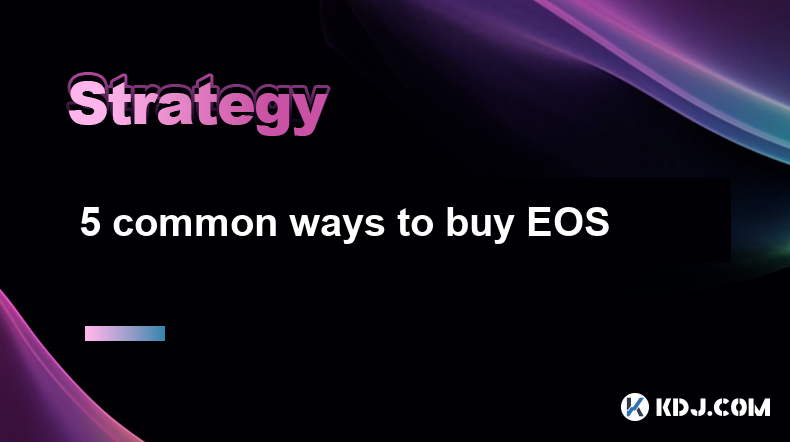
5 common ways to buy EOS
Apr 10,2025 at 01:14am
When it comes to purchasing EOS, one of the prominent cryptocurrencies in the blockchain ecosystem, there are several methods you can use. Each method has its own set of advantages and considerations. In this article, we will explore five common ways to buy EOS, providing a detailed guide on how to navigate each option effectively. Using Cryptocurrency ...
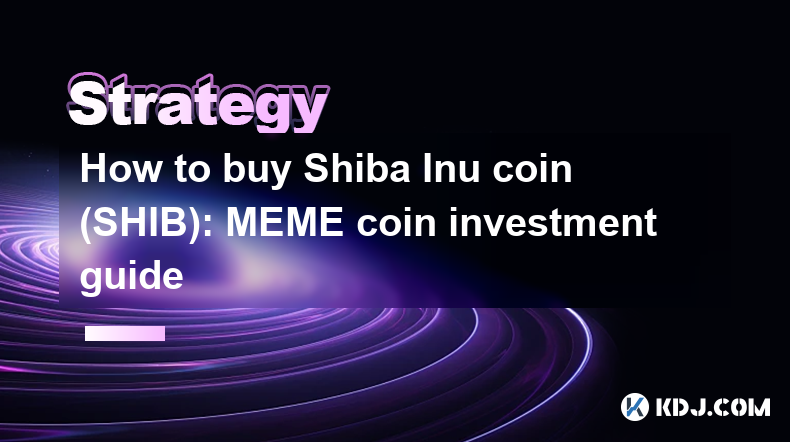
How to buy Shiba Inu coin (SHIB): MEME coin investment guide
Apr 10,2025 at 07:42am
Buying Shiba Inu coin (SHIB), a popular meme coin, can be an exciting venture into the world of cryptocurrency. This guide will walk you through the steps to purchase SHIB, provide insights into the coin's background, and offer tips on managing your investment. Whether you're a seasoned crypto investor or a newcomer, understanding how to buy and manage ...

7 key steps to buy Cardano (ADA)
Apr 12,2025 at 02:28am
Buying Cardano (ADA), one of the leading cryptocurrencies, can be an exciting venture into the world of digital assets. Whether you're a seasoned investor or a newcomer, understanding the process is crucial. Here are the 7 key steps to buy Cardano (ADA) that will guide you through the journey of acquiring this promising cryptocurrency. Step 1: Research ...

A complete guide to buying Solana (SOL): Mobile/computer dual platform teaching
Apr 11,2025 at 02:50am
A Complete Guide to Buying Solana (SOL): Mobile/Computer Dual Platform Teaching Purchasing Solana (SOL), one of the leading cryptocurrencies known for its high throughput and low transaction costs, can be done through various platforms. This guide will walk you through the process of buying SOL on both mobile and computer platforms, ensuring you have a ...
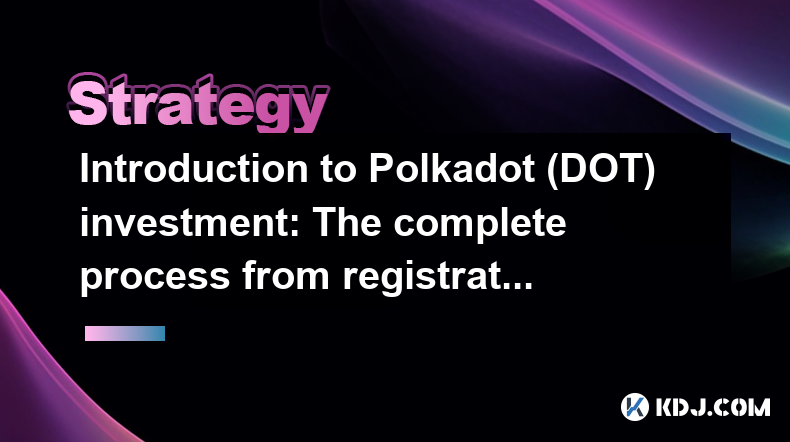
Introduction to Polkadot (DOT) investment: The complete process from registration to purchase
Apr 10,2025 at 09:21pm
Introduction to Polkadot (DOT) Investment: The Complete Process from Registration to Purchase Polkadot (DOT) has emerged as a significant player in the cryptocurrency market, offering a unique approach to blockchain interoperability. For those interested in investing in DOT, understanding the complete process from registration to purchase is crucial. Th...
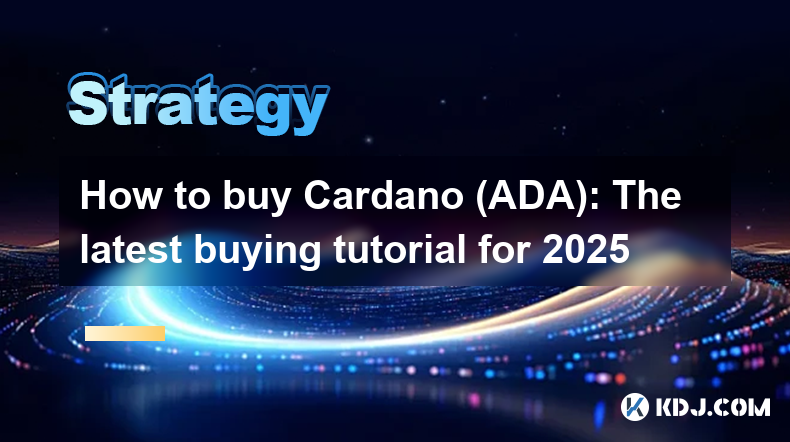
How to buy Cardano (ADA): The latest buying tutorial for 2025
Apr 09,2025 at 01:21am
Introduction to Cardano (ADA)Cardano (ADA) is a blockchain platform that aims to provide a more secure and scalable infrastructure for the development of decentralized applications and smart contracts. Created by Charles Hoskinson, one of the co-founders of Ethereum, Cardano differentiates itself through its rigorous academic approach and peer-reviewed ...

5 common ways to buy EOS
Apr 10,2025 at 01:14am
When it comes to purchasing EOS, one of the prominent cryptocurrencies in the blockchain ecosystem, there are several methods you can use. Each method has its own set of advantages and considerations. In this article, we will explore five common ways to buy EOS, providing a detailed guide on how to navigate each option effectively. Using Cryptocurrency ...

How to buy Shiba Inu coin (SHIB): MEME coin investment guide
Apr 10,2025 at 07:42am
Buying Shiba Inu coin (SHIB), a popular meme coin, can be an exciting venture into the world of cryptocurrency. This guide will walk you through the steps to purchase SHIB, provide insights into the coin's background, and offer tips on managing your investment. Whether you're a seasoned crypto investor or a newcomer, understanding how to buy and manage ...

7 key steps to buy Cardano (ADA)
Apr 12,2025 at 02:28am
Buying Cardano (ADA), one of the leading cryptocurrencies, can be an exciting venture into the world of digital assets. Whether you're a seasoned investor or a newcomer, understanding the process is crucial. Here are the 7 key steps to buy Cardano (ADA) that will guide you through the journey of acquiring this promising cryptocurrency. Step 1: Research ...

A complete guide to buying Solana (SOL): Mobile/computer dual platform teaching
Apr 11,2025 at 02:50am
A Complete Guide to Buying Solana (SOL): Mobile/Computer Dual Platform Teaching Purchasing Solana (SOL), one of the leading cryptocurrencies known for its high throughput and low transaction costs, can be done through various platforms. This guide will walk you through the process of buying SOL on both mobile and computer platforms, ensuring you have a ...

Introduction to Polkadot (DOT) investment: The complete process from registration to purchase
Apr 10,2025 at 09:21pm
Introduction to Polkadot (DOT) Investment: The Complete Process from Registration to Purchase Polkadot (DOT) has emerged as a significant player in the cryptocurrency market, offering a unique approach to blockchain interoperability. For those interested in investing in DOT, understanding the complete process from registration to purchase is crucial. Th...

How to buy Cardano (ADA): The latest buying tutorial for 2025
Apr 09,2025 at 01:21am
Introduction to Cardano (ADA)Cardano (ADA) is a blockchain platform that aims to provide a more secure and scalable infrastructure for the development of decentralized applications and smart contracts. Created by Charles Hoskinson, one of the co-founders of Ethereum, Cardano differentiates itself through its rigorous academic approach and peer-reviewed ...
See all articles






















































































